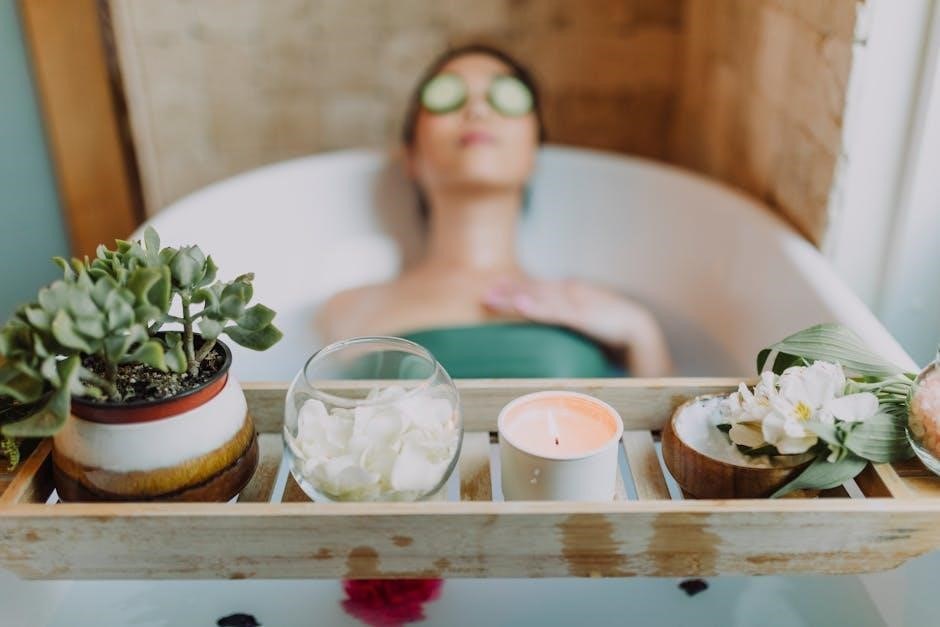Self-guided trips offer travelers independence and flexibility, allowing them to explore destinations at their own pace, immersing in local cultures and creating personalized, unforgettable experiences.
Definition and Overview
A self-guided trip is a travel experience where individuals plan and execute their journey independently, without relying on a tour guide or group. It offers flexibility and autonomy, allowing travelers to create personalized itineraries tailored to their interests and preferences. Self-guided trips often involve pre-researched routes, activities, and accommodations, enabling travelers to explore destinations at their own pace. This approach is ideal for those who enjoy independence and wish to immerse themselves in local cultures, landscapes, and cuisines. By taking control of their travel plans, adventurers can craft unique experiences that align with their passions and goals, making each trip truly memorable and fulfilling.
Benefits of Self-Guided Travel
Self-guided travel offers unparalleled freedom and flexibility, allowing travelers to tailor their experiences to personal preferences and interests. It fosters independence, enabling individuals to explore at their own pace and make spontaneous decisions. This style of travel often reduces costs compared to guided tours, as it eliminates fees for guides and rigid itineraries. Additionally, self-guided trips encourage deeper immersion in local cultures, as travelers engage directly with environments and communities. The ability to create a personalized journey enhances satisfaction and creates lasting memories, making self-guided travel a rewarding choice for adventurous and curious individuals seeking unique experiences.
Who Should Consider Self-Guided Trips?
Self-guided trips are ideal for adventurous travelers who enjoy independence and flexibility. They suit individuals who prefer exploring at their own pace, immersing deeply into local cultures, and creating personalized experiences. These trips are perfect for budget-conscious travelers, as they often cost less than guided tours. Experienced travelers who feel confident navigating unfamiliar places will thrive in this setup. Additionally, self-guided trips appeal to those seeking solitude, couples looking for intimate moments, and families wanting to tailor activities to their preferences. Ultimately, anyone eager to take control of their travel journey and embrace new challenges can benefit from a self-guided adventure.

Planning a Self-Guided Trip
Planning a self-guided trip involves thorough research, setting clear objectives, and organizing logistics such as transportation and accommodation to ensure a smooth and enjoyable journey.
Choosing a Destination
When selecting a destination for a self-guided trip, consider your budget, interests, and travel style. Research destinations by reading travel blogs, forums, and social media for insights and inspiration. Assess factors like safety, accessibility, and cultural appeal. Match the location to your experience level, whether you’re a novice or seasoned traveler. Ensure the destination aligns with your goals, such as adventure, relaxation, or cultural immersion. Check visa requirements, health guidelines, and local conditions to plan effectively. By thoughtfully choosing a destination, you set the foundation for a fulfilling and enjoyable self-guided adventure.
Setting Travel Goals and Objectives
Setting clear travel goals and objectives is crucial for a self-guided trip, ensuring a focused and fulfilling experience. Define what you aim to achieve, whether exploring cultural landmarks, immersing in local cuisine, or adventuring in nature. Align your goals with your interests, budget, and time constraints. Prioritize must-see attractions while leaving room for spontaneity; Consider the duration of your trip and the pace you wish to maintain. Establishing objectives helps create a balanced itinerary, allowing you to make the most of your journey. Flexibility is key, but having a clear direction ensures a meaningful and memorable adventure tailored to your preferences.
Creating a Detailed Itinerary
Creating a detailed itinerary is essential for a smooth self-guided trip. Start by listing must-see attractions, activities, and experiences. Research opening hours, ticket requirements, and travel times between locations. Use tools like spreadsheets or travel apps to organize your schedule. Be realistic about how much you can accomplish each day, balancing sightseeing with downtime. Includebuffer time for unexpected delays or spontaneous adventures. Prioritize your goals to ensure you don’t miss key experiences. Finally, leave some flexibility in your plan to adapt as you go, allowing for changes based on local recommendations or personal preferences. A well-structured itinerary enhances your travel experience and reduces stress.

Research and Preparation
Understanding Local Culture and Customs
Researching local traditions, etiquette, and laws ensures respectful travel, fostering positive interactions with communities and enhancing cultural immersion.
Researching Transportation Options
Comparing transportation methods, schedules, and costs helps plan efficient routes, ensuring smooth transitions between destinations.
Booking Accommodation Independently
Comparing prices, reading reviews, and securing bookings in advance guarantees convenient, budget-friendly stays tailored to travel preferences.
Understanding Safety and Security Measures
Gathering information on local safety, health guidelines, and emergency contacts ensures preparedness and confidence during independent travel.
Understanding local culture and customs is crucial for a seamless self-guided trip. Researching cultural norms, traditions, and etiquette ensures respect and enriches your experience. Familiarize yourself with local dress codes, dining habits, and social interactions. Learning a few basic phrases in the local language can foster positive interactions. Additionally, understanding cultural taboos and historical context helps avoid unintentional offense. Carry a guidebook or use apps for real-time insights into local customs. Respecting traditions, such as removing shoes in temples or greeting locals appropriately, enhances your cultural immersion. This preparation not only ensures safety but also deepens your connection with the destination’s heritage and people.
Researching transportation options is crucial for a smooth self-guided trip. Start by identifying available public transport, such as buses, trains, or ferries, which are often cost-effective. Consider renting a car for flexibility, especially in remote areas. Walking and biking are eco-friendly alternatives for shorter distances. Use online tools like route planners and apps to map out journeys. Compare costs and schedules to budget effectively. Booking tickets in advance can secure better prices. Additionally, familiarize yourself with local driving laws if planning to rent a vehicle. Understanding transportation logistics ensures efficient travel and maximizes exploration opportunities.
Booking accommodation independently is a key part of self-guided trips, offering flexibility and cost savings; Researching areas in advance, comparing prices across platforms, and reading reviews helps ensure quality stays. Many travelers use platforms like Airbnb, Booking.com, or Hotels.com for convenience. It’s important to understand cancellation policies and amenities before finalizing a booking. Booking in advance during peak seasons is recommended to secure options. Additionally, communicating directly with hosts or hotels can provide insights into local tips and hidden gems, enhancing your travel experience. Always verify the location’s proximity to transportation and attractions to make navigation easier during your trip.
Understanding safety and security measures is crucial for self-guided trips. Researching your destination thoroughly, including local laws, political stability, and health risks, ensures preparedness. Stay informed about potential hazards such as pickpocketing or scams in tourist areas. Carry emergency contacts, including local authorities and your embassy. Always have a plan for unexpected situations, like a backup accommodation or transportation options. Trust your instincts and avoid risky situations, especially at night. Keeping valuables secure and being mindful of your surroundings can significantly reduce risks. Remember, awareness and preparation are key to a safe and enjoyable self-guided adventure.
- Stay informed about local conditions.
- Carry emergency contacts.
- Be cautious in crowded areas.

Budgeting for a Self-Guided Trip
Budgeting for a self-guided trip involves estimating costs, allocating funds for transportation, accommodation, and activities, and using money-saving strategies to maximize your travel experience.
- Estimate total expenses.
- Allocate funds wisely.
- Use budgeting tools.
Estimating Total Costs
Estimating total costs for a self-guided trip is essential for budgeting effectively. Start by researching average expenses for transportation, accommodation, food, and activities in your destination. Consider entry fees for attractions, visa costs, and miscellaneous spending. Use online tools or travel blogs to gauge daily expenses. Allocate funds based on priorities, such as sightseeing or dining. Factor in exchange rates if traveling internationally. Budgeting apps can help track estimated costs and ensure you stay within limits. Always add a buffer for unexpected expenses to avoid financial stress during your trip. Proper planning ensures a balanced and enjoyable journey without overspending.
Allocating Funds for Transportation, Accommodation, and Activities
Allocating Funds for Transportation, Accommodation, and Activities
Allocating funds for transportation, accommodation, and activities is crucial for a self-guided trip. Start by estimating total costs based on destination and duration. Transportation, including flights, trains, and rentals, often consumes a significant portion of the budget. Accommodation costs vary widely depending on location and type, with options like hostels, hotels, or rentals. Activities, such as tours, entrance fees, and dining, should also be budgeted. Consider allocating 30-40% for accommodation, 20-30% for transportation, and 30-40% for activities and food. Prioritize spending based on personal preferences and research deals or discounts to maximize value. This balanced approach ensures a memorable and stress-free journey.
Money-Saving Tips for Independent Travelers
Independent travelers can save money by planning ahead and researching discounts. Booking accommodations and transportation in advance often results in lower costs. Consider flexible travel dates, as prices vary by day and season. Packing smartly reduces extra baggage fees, and opting for free walking tours or self-guided city exploration saves money on guided services. Cooking meals instead of dining out and using public transport or walking can significantly cut expenses. Additionally, setting a daily budget and tracking spending helps stay on financial track. Utilizing travel apps and websites for deals and comparing prices ensures maximum savings, making self-guided trips more affordable and enjoyable.

Packing for a Self-Guided Adventure
Packing light and smart is essential for self-guided trips, ensuring versatility and comfort while exploring.
Include essentials like navigation tools, portable chargers, and versatile clothing to stay prepared for any situation.
Essentials to Bring Along
When embarking on a self-guided trip, it’s crucial to pack smartly. Start with travel documents like passports, visas, and travel insurance. Navigation tools such as maps, GPS devices, or a reliable smartphone with offline maps are indispensable. Practical gear like a sturdy backpack, reusable water bottle, and universal power adapter ensures convenience. Don’t forget health and safety items, including a first-aid kit, medications, and emergency contact details. Electronics like cameras and portable chargers are must-haves for capturing memories. Pack versatile, weather-appropriate clothing and personal care essentials. Strike a balance between overpacking and underpacking to maintain flexibility. Always check the weather forecast before finalizing your luggage for a seamless adventure.
Packing Light and Smart
Packing light and smart is essential for self-guided trips, ensuring ease of movement and reducing luggage-related stress. Start by selecting versatile, multi-use items and avoid overpacking. Choose a sturdy, compact backpack or suitcase with compartments for organization. Consider the weather and activities planned, packing layered clothing that can adapt to different conditions. Roll your clothes to save space and minimize wrinkles. Limit shoes to a pair of comfortable walking shoes and one dressier option if needed. Use packing cubes to keep items tidy and accessible. Remember, it’s better to leave some extra space for souvenirs and items purchased during your trip. Always check airline or transport restrictions beforehand.
Technology and Gear for Navigation
Navigation is crucial for self-guided trips, and the right technology and gear can make the journey seamless. A reliable smartphone with GPS apps like Google Maps or specialized travel apps is indispensable. Portable chargers and power banks ensure your devices stay powered. Consider carrying a physical map as a backup in areas with poor connectivity. Additionally, a compact telescope or binoculars can enhance scenic views. Investing in durable, travel-friendly gear ensures you stay connected and informed, empowering you to explore confidently without missing any hidden gems or essential landmarks along your route.

Navigating Without a Guide
Navigating independently involves using maps, GPS, and local signage to explore destinations confidently, ensuring a seamless and self-directed travel experience without reliance on guided tours.
Using Maps and GPS for Directions
Reliable maps and GPS tools are essential for self-guided travelers, providing real-time navigation and minimizing the risk of getting lost. Apps like Google Maps and GPS-based devices offer turn-by-turn directions, even in remote areas. Offline map downloads ensure functionality without internet access, a lifesaver in regions with poor connectivity. GPS also helps estimate travel times and suggests alternative routes, adapting to unexpected detours. For international trips, downloading local maps and learning basic landmarks can enhance navigation accuracy. Combining digital tools with physical maps ensures a seamless journey, allowing travelers to focus on enjoying their surroundings rather than constantly searching for directions.
Communication Strategies in Foreign Languages
When traveling independently, effective communication in foreign languages is crucial. Learning basic phrases like greetings, directions, and food orders can significantly enhance your experience. Carry a translation app or phrasebook for quick references. Engage with locals by asking for recommendations, which fosters cultural connections. Use hand gestures and visual aids to bridge language gaps. Many locals appreciate efforts to communicate in their language, even if imperfect. Additionally, using online tools for real-time translations can help navigate complex situations. Mastering these strategies ensures smoother interactions and enriches your self-guided journey, allowing you to fully immerse in the local culture and make meaningful memories.
Handling Unexpected Challenges
Unexpected challenges, like getting lost or facing language barriers, are inevitable in self-guided trips. Staying calm and resourceful is key. Use GPS apps or maps to navigate, and carry translation guides or phrasebooks for communication. Pack essentials like a first-aid kit and emergency contacts. Flexibility is crucial—unexpected detours can lead to unique experiences. Trust your instincts for safety and seek help when needed. Embrace challenges as part of the adventure, fostering personal growth and memorable stories. Preparation and adaptability ensure a smoother journey, turning potential setbacks into opportunities for discovery and connection with local cultures.

Engaging with Local Culture
Immersing in cultural festivals, traditions, and local events enriches self-guided trips, allowing travelers to experience authentic customs and connect deeply with the community’s heritage and way of life.
Exploring Local Cuisine
Self-guided trips provide the perfect opportunity to dive into local culinary traditions, allowing travelers to discover authentic flavors and hidden gems. By venturing beyond tourist hotspots, adventurers can enjoy regional dishes, street food, and family-run restaurants that reflect the true essence of a destination. This freedom enables travelers to explore markets, food festivals, and cooking classes, fostering deeper cultural connections. Engaging with local cuisine not only enriches the travel experience but also supports small businesses and communities. Whether it’s navigating menus in a foreign language or sampling unfamiliar delicacies, exploring local food becomes a memorable part of the journey, blending taste, tradition, and adventure seamlessly.
Visiting Hidden Gems and Off-the-Beaten-Path Locations
Self-guided travelers often seek hidden gems and off-the-beaten-path destinations to experience authentic local culture and untouched natural beauty. These lesser-known spots offer a unique opportunity to explore without crowds, creating more intimate and memorable experiences. To discover such locations, travelers can engage with locals, research niche travel blogs, or use specialized apps that highlight unconventional attractions. Flexibility in planning allows for spontaneous detours to these secret spots, making self-guided trips particularly rewarding. By venturing beyond popular tourist sites, travelers can uncover the true essence of a destination, fostering deeper connections with the environment and its people.
Interacting with Locals
Engaging with locals is a cornerstone of self-guided travel, offering authentic cultural insights and memorable experiences. Learning a few phrases in the local language can foster deeper connections and show respect for the community. Participating in local events, visiting markets, or joining workshops allows travelers to immerse themselves in daily life. Staying open-minded and curious encourages meaningful interactions, whether through casual conversations or shared activities. Technology, such as translation apps, can bridge language gaps, enabling travelers to communicate effectively. These interactions not only enrich the journey but also create lasting memories and a sense of belonging, making self-guided trips truly rewarding.

Documenting Your Journey
Capturing memories through photography, journaling, and social media allows travelers to reflect on their experiences and share their adventures, preserving the essence of their self-guided journey.

Photography Tips for Travelers
Capturing memories through photography enhances your self-guided trip experience. Shoot during the golden hour for stunning lighting and experiment with angles to add depth. Use a tripod for low-light conditions and apply the rule of thirds for balanced compositions. Carry extra memory cards and batteries to avoid missing moments. Respect local culture and always ask permission before taking photos of people. Focus on candid shots to capture authentic moments. Edit photos minimally to preserve their natural beauty. Consider using a polarizing filter to enhance colors and reduce glare. Lastly, organize your photos with keywords for easy access and sharing on travel blogs or social media.
Keeping a Travel Journal
A travel journal is a meaningful way to document your self-guided trip, capturing memories, reflections, and insights. By recording daily experiences, you preserve the essence of your journey, from breathtaking landscapes to unexpected encounters. Include photos, ticket stubs, and handwritten notes to make it personal. Reflecting on your entries helps you process your adventures and identify personal growth. Over time, your journal becomes a cherished memento, allowing you to relive your travels and share stories with others. It’s also a valuable resource for future trips, offering lessons learned and inspiration for new destinations. Writing in a journal enriches your travel experience and creates a lasting legacy of your adventures. Use it to celebrate your independence and creativity as a self-guided traveler.
Sharing Experiences on Social Media
Sharing your self-guided trip experiences on social media allows you to connect with fellow travelers and inspire others. Use platforms like Instagram, TikTok, or YouTube to post high-quality photos, videos, and stories. Include engaging captions with hashtags to increase visibility. Highlight unique moments, local cuisine, and hidden gems you discover. Consider creating a travel blog or vlog to document your journey in detail. Geotags and location-specific hashtags can help others plan similar trips. Engage with your audience by responding to comments and messages, building a community around your adventures. Sharing tips and insights can also help others plan their own self-guided trips effectively.

Evaluating Your Trip
Reflecting on experiences, gathering feedback, and sharing insights are crucial steps in evaluating a self-guided trip, helping travelers refine future adventures and share valuable knowledge with others.
Reflecting on Your Experiences
Reflecting on your self-guided trip experiences is a powerful way to process memories and growth. Documenting your journey through journals or blogs allows you to revisit highlights and challenges. Evaluating decisions, like itinerary choices or budget allocations, helps identify what worked well and what could improve. Sharing insights with others fosters connections and provides valuable feedback for future travelers. This reflection also deepens personal growth, as you recognize how independent travel shaped your confidence and problem-solving skills. Embracing these moments of introspection enhances the overall value of your self-guided adventure, turning it into a lifelong learning experience.
Gathering Feedback for Future Trips
Gathering feedback after a self-guided trip is essential for improving future travel experiences. Reflect on what worked well and what didn’t, considering factors like itinerary pacing, accommodation choices, and activity selections. Use travel journals or photos to jog your memory. Analyze how well your pre-trip research aligned with reality and identify areas for improvement. Seek input from fellow travelers or online communities to gain new insights. This process helps refine planning strategies and ensures future trips are even more enjoyable. Continuous feedback loop enhances travel satisfaction and fosters personal growth as an independent explorer.
Sharing Tips with Fellow Travelers
Sharing tips with fellow travelers fosters a sense of community and mutual support. By documenting your experiences and offering advice, you help others plan their trips more effectively. Platforms like social media, travel forums, and blogs are ideal for sharing insights, from hidden gems to practical strategies. Engaging with others can also enhance your own travel knowledge and inspire future adventures. Encouraging others to embrace self-guided travel promotes independence and confidence. Your stories and tips can motivate someone to take their first step into independent exploration, creating a ripple effect of shared discovery and growth.
Self-guided trips are a journey of discovery, empowering travelers with flexibility and independence, creating unforgettable memories through personalized experiences and cultural immersion.
Final Thoughts on Self-Guided Travel
Self-guided travel empowers adventurers to craft unique, personalized journeys, fostering deeper connections with destinations and cultures. By taking control of their experiences, travelers gain confidence, flexibility, and the freedom to explore at their own pace. This approach allows for authentic, unforgettable moments, whether discovering hidden gems or immersing in local traditions. While it requires careful planning and adaptability, the rewards of self-guided travel are immense. It’s an opportunity to step out of your comfort zone, embrace spontaneity, and create memories that resonate long after the trip ends. For those seeking independence and meaningful experiences, self-guided travel is a transformative way to explore the world.
Encouragement to Try Independent Travel
Embarking on a self-guided trip is a transformative experience that fosters independence and confidence. By taking control of your journey, you can discover hidden gems, connect deeply with local cultures, and create meaningful memories. It’s an opportunity to step out of your comfort zone and grow personally. While it may seem daunting at first, the freedom to explore at your own pace is incredibly rewarding. Don’t hesitate to embrace the adventure—self-guided travel empowers you to tailor your experiences and make every moment count. Give it a try and uncover the joy of traveling on your own terms!

Leave a Reply
You must be logged in to post a comment.